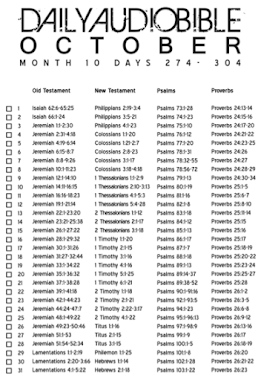
Whenever the new year approaches, Christians
Christians tend to pick up a bible-reading plan of some sort, and most of the time it goes through the scriptures in a year. Which, I insist, is far too long. I prefer
Now if a month seems too extreme for you (especially if you don’t read), y’know what you could do: Read the bible at your own speed. Read it till you’re done. However long it takes you to get it done. Might be three months. Maybe two. Then again you might surprise yourself and finish it in one.
That’s where TXAB’s bible-reading plan comes in. It’ll help you read it at whatever speed you’re going.
I read the entire bible, in an unfamiliar translation, every January. And sometimes again in August. When I do so, I read each of the books—but in no particular order. I start with whichever book I feel like reading most. I follow it with whatever book I feel like reading next. And so on, and so on, till I finish.
Most people read the bible the very same way. Except they don’t keep track of what they read, and what they haven’t. Fr’instance a person (and we’ll call her Apolonia) decides she wants to read John, ’cause it’s her favorite. Then she reads James, ’cause her pastor’s preaching a series on it. Then Philippians, ’cause her bible study is going through it. Then she reads Romans, ’cause somebody told her she really oughta. Then Genesis, because she feels she really oughta. Then somebody says something profound from Romans, so she decides to reread that book again. And then Genesis again. She’ll bounce all over the bible, which is fine. But she’ll skip books, which isn’t so good.
Well here’s how to avoid skipping books: A checklist.
When you click on it, you get a high-resolution version which you can print out. So if Apolonia had this checklist, she could read any chapter of the bible at any time, then check it off and know how much she still has to slog through read.
As can you. Start wherever. Jump around. Just keep track of what you read: Every time you finish a chapter, check it off. Read till every box is checked. Read a chapter a day, or two, or ten; however many chapters you feel comfortable with.
If you skip a day, big deal. This isn’t a schedule. It’s a checklist. You don’t have to scramble to catch up, or feel guilty if you got too busy and got irregular about it. Just pick up where you left off. Or bounce over to another book and read that. If it takes you a year to get all the way through the bible, that’s okay. If it takes two years, that’s okay too. If it takes you a month, good job! But whatever your speed is.
Most people, if they just remember to read every day, will easily finish in four months or less.
Other reading plans.
Obviously I’m a big fan of my own reading plan. But your circumstances may be different.
My sister’s church has its own reading plan, a church-wide schedule where you read a little bit each day. You know the type. A little Old Testament, a little New Testament, a little poetry, 365 days a year. Now, if your entire church is going through such a program, it’s a really good idea to sync up with them. I guarantee you: Your church’s daily reading is gonna come up from time to time—in the bible studies, in the sermons, in conversations between fellow church members. If you aren’t familiar with what everybody else is reading—much like keeping up with sports or a popular TV show—you’re gonna feel left out. Or behind. It’s not gonna help you grow together, which is part of the point of churchwide reading plans.
This sort of reading plan is pretty common. Here’s a link to DailyAudioBible’s program. I’ll show you how they schedule October:

If you start on 1 October you’d read Isaiah 62.6, Philippians 2.19, Psalm 73, and Proverbs 24.13. Through the month you’d read—
- The rest of Isaiah, which is only a few chapters.
- Everything Jeremiah wrote: Jeremiah and Lamentations.
- Paul’s Philippians, Colossians, 1–2 Thessalonians, and his “pastoral epistles” of 1–2 Timothy, Titus, and Philemon,
- Hebrews up to 2.18.
- Psalms 73–103.
- A little bit of Proverbs; 24.13 to 26.23.
That’s about 10 books and change. Small books, but still not too shabby.
On your own, you might think reading just five books within a month might be a big achievement. It’s really not. Bible books are small. Daily Audio Bible’s program doesn’t give you giant daily readings. They’ll take maybe 15 minutes a day.
My only problem with them: These books really ought to be read as a whole. Not in segments. Titus is a tiny little letter, but reading it a chapter a day, mixed in with other things, means you’re likely to miss the overall themes of the letter. Reading Jeremiah’s prophecies one at a time makes you miss the subtle differences between them… and you might start to think of Jeremiah as nothing but the same dire predictions, told over and over again by the same whiny guy.
In a nutshell:
True, my checklist lists the bible chapter by chapter. But not so you only read it one chapter at a time. I’d really recommend you don’t! It’s just if you stop a book in the middle, you can mark what you’ve read thus far. It’s meant to free, not limit, your reading. Capisce?
Okay. Get to reading.


